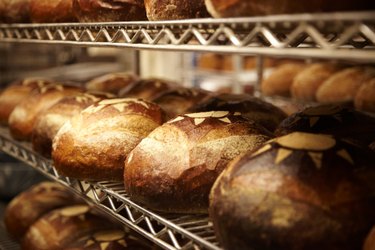Things You'll Need
Measuring cup
Water
Cooking thermometer
1 package active dry yeast
1 tbsp. sugar
Spoon

Dissolving yeast is an important part of the yeast-based baking process. Breads, rolls, dough and other similar baked goods require yeast to add air to the mixture. This prevents the finished product from becoming hard and heavy while baking. Yeast also helps make dough flexible and pliable for kneading. Dissolving the yeast in water prior to making the dough starts the fermentation process. It also helps determine if the yeast is still fresh. Old yeast will not expand the dough and produce undesirable results.
Step 1
Fill a bowl with the amount of water indicated in the recipe. Typically, it is 1 cup of water per package of yeast. Use water between 105 degrees and 115 degrees Fahrenheit. This is the best temperature for dissolving yeast without killing it.
Video of the Day
Step 2
Sprinkle the yeast over the water. Allow to sit for two minutes.
Step 3
Stir the yeast into the water gently until dissolved. The water will look cloudy.
Step 4
Add sugar to the water and stir.
Step 5
Allow the yeast mixture to sit for another three to five minutes. The yeast should start to bubble or foam in the water.
Step 6
Add the yeast mixture to the rest of the ingredients as directed in your recipe as soon as possible after it begins to bubble. This allows the yeast to combine with the other ingredients to produce the best results.
Tip
Check the expiration date on the yeast. If the date indicates it is expired, do not use it and replace it with fresh yeast.
If the yeast does not bubble and foam when mixed with water, then the yeast is likely dead. If you use dead yeast, then your dough will not rise and your baked goods will be too dense to properly enjoy. Do not use the mixture and start again with fresh yeast.
Video of the Day